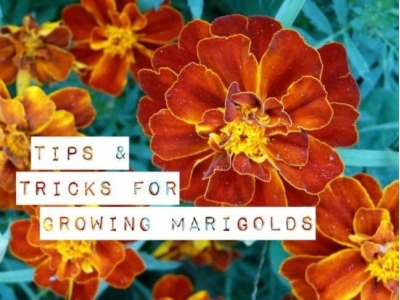Growing Marigolds: Tips and Tricks

Interested in having a flower garden? Look no further...Marigolds are easy to grow and have many uses.
Marigolds are most commonly thought to be the little orange and yellow flowers everybody grows because everybody can grow them. Their tolerance for less-than-perfect soil conditions, their ability to thrive in all but the coldest and harshest of climates, and their naturally forgiving nature when it comes to care (or lack thereof) makes them a favorite of gardeners throughout the world. But there’s much more to these little beauties than meets the eye.
The name ‘marigold’ means Mary’s Gold, and comes from one of the oldest-known species of marigolds -- the calendula (or pot marigold). Other species of marigolds include the common marigold, tree marigold, Mexican marigold, corn marigold and the French marigold

CC photo courtesy of dancerinthedark
All but the most hybridized varieties of marigolds are perennials. In the warmest regions the plants thrive year round, while in colder zones, they act as self-seeding annuals if you deadhead the blooms and drop them onto the ground.
Marigolds can be started indoors in early spring to be ready to transplant into the ground or larger pots when weather permits, or the seed can be sown directly into the soil after all danger of frost is past.
It’s usually not a question of whether or not to have marigolds. It’s more a question of what kind and how many to plant. Marigolds aren’t only attractive, they’re useful as well.
Did you know….
1. Marigolds are proven nectar sources for butterflies, making them a popular pick for butterfly gardens.
2. The pigments in their bold colors are approved in Europe for use in the coloring of many food items.
3. Marigolds are a natural repellent of nematodes and other garden pests. Planting marigolds in and around your tomato, eggplant, pepper and potato plants will result in healthier plants and produce.
4. The pungent smell of marigolds will also keep rabbits, deer and rodents from eating your plants.
5. Marigolds have medicinal purposes. Some species of marigolds are used antiseptically to treat athlete’s foot, bites and stings.
Another reason for the popularity of the marigold is its ability to bloom and bloom and bloom…. When all else is fading from your garden, marigolds will still be going strong. And what makes that even better, is that by using different sizes and colors of marigolds, your flower garden will look as if it’s flourishing even near the end of the season.
Common, French and pot marigolds can be grown in the ground or in pots. In the harshest of climates (hot or cold) they will require a bit of extra attention. The hottest of climates will necessitate closer attention to watering, while in climates experiencing harsh winter temperatures the pots will need to be placed in a cellar, basement or garage during the winter.
If you’re fortunate enough to live in a tropical climate, the tree marigold is an option for you. Sometimes called the Mexican Sunflower, the thick woody stem is tree-like and they grow up to eight feet tall.
Corn marigolds, which until recently were considered to be in the chrysanthemum family, resemble a daisy. Their blooms of bright yellow leaves tipped in white are anchored in the center by a large yellow disc. The corn marigold is taller than the more common marigolds. While not native to the United Sates, they grow so profusely in parts of Europe that they are considered an invasive weed.
Marigolds aren’t terribly fussy. As long as they get a fair amount of sunshine (the more the better) and the soil they’re in is on the dry side, they thrive and bloom continually until the first hard frost of autumn.
Related news
 How to Grow Lamium
How to Grow Lamium Looking for a fast-growing, attractive ground cover for shady areas? Consider lamium (Lamium maculatum), sometimes known as spotted dead nettle.
 How To Make Gardening Easier
How To Make Gardening Easier Gardening is fun, healthy, and a smart way to enhance the quality of the food your family eats and the beauty of your indoor and outdoor spaces.
 How to Use Recycled Coffee Grounds in Your Garden
How to Use Recycled Coffee Grounds in Your Garden They can go right into the compost pail, and just give the pile a bit of a stir when you add the pail with the coffee grounds, to make sure they spread out well